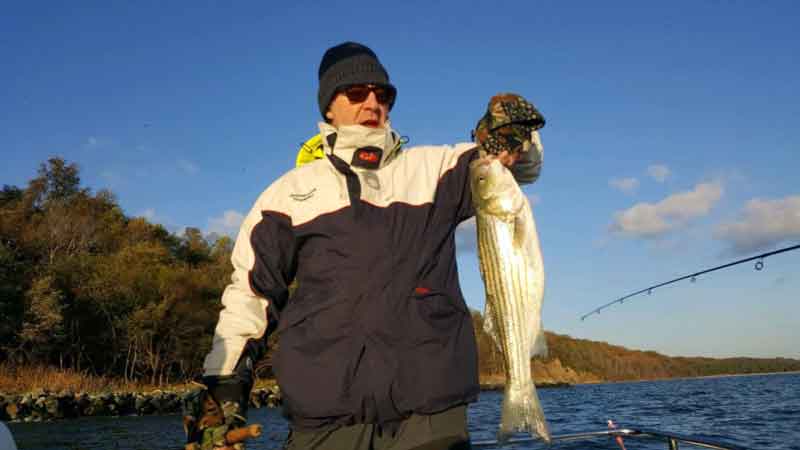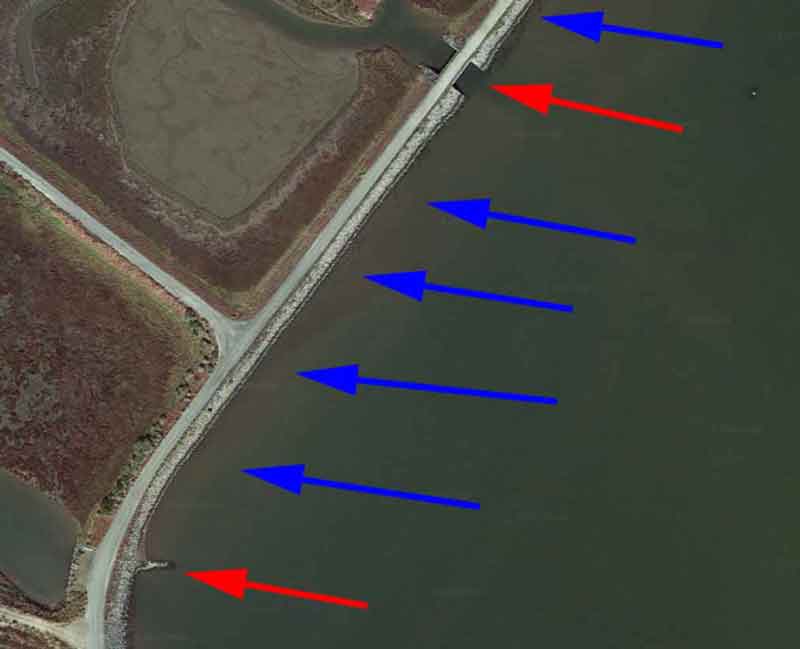If you enjoy Chesapeake Bay fishing during the fall, there's no doubt you've heard some fact and some fiction about when and where those stripers will bite.
- Fact: when it goes from “chilly” to “cold” stripers put on the feed bag and eat like nuts to fatten up for winter, often leading to better fishing.
- Fact: when it goes from “chilly” to “cold” there’s a lot less competition out on the water, often leading to better fishing.
- Fact: when it goes from “chilly” to “cold” the fish commonly extend their feeding times beyond the tidal ranges that usually dictate activity levels during the warmer months of the year, often leading to better fishing.
- Fiction: when it goes from “chilly” to “cold” stripers leave the shallows and move to deeper water.

Sure, there’s a point at which rockfish will abandon the shallows for the season and move to deeper areas. But that point is usually when it goes from “cold” to “freezing.” In fact, I’ve plucked keeper fish off of riprap in a foot of water on the closing day of the season — back when the season ran until December 21 — so don’t stop working shorelines just because it’s a little bit cold outside.
Speaking of shorelines, the use of riprap to slow shoreline erosion has given us hundreds if not thousands of spots that are rich with rocky edges and outcroppings. Ever wonder why we call striped bass “rockfish,” when in all other parts of the country they’re known as striped bass? Because we’re right and they’re wrong, of course. But also because wherever you find rocks, you tend to find these fish.
Riprap Retrieves
Whenever you hit riprap your basic tactics should be the same: cast as close as possible to the rocks and then retrieve, while positioning your boat as far away from them as possible to minimize the danger of spooking the fish. Just how close is close enough? Your lure should be splashing down within a foot or so of the rocks to maximize the bites. The fish will usually be facing the rocks as they hunt for the minnow, grass shrimp, and small crabs hiding among them, so a lure falling several feet short often won’t even be seen by the predators. But remember that the water may only be inches deep where your lure splashes down, so stick with very light jig heads of 1/8 or 1/4 ounce and keep your retrieve fast with your tip up high, or use floating lures. Otherwise, you’ll likely get snagged in the rocks.
Good jigs for the shallows include chartreuse, white, and pearl four- to six-inch plastics. Shad bodies, paddle-tails, and twister-tails will all work. Casting topwater usually results in slightly fewer hook-ups, but the excitement of the explosion and the snag-free nature of these lures more than makes up for it in the eyes of many anglers. Another good option is to cast a floating Rat-L-Trap style of swimming plug, though we should note that with all of these plugs, in the interest of minimizing injury to undersized fish the treble hooks should be swapped out for singles.
One of the key factors to being successful in the shallows is knowing how and when to keep your noise levels down. We don’t think of this factor too often here in the Bay because we don’t usually see the fish we’re casting for. But in places where the water is gin-clear, like the Florida flats, you’ll discover that anglers are incredibly attentive to the sounds they make because when they spook a fish they can see it dart off with their own eyes. Rockfish get spooked, too, we just don’t notice it most of the time. Slamming hatches, speaking loudly, or even just dropping something on the deck can be all it takes to freak those fish out.
Reading the Riprap
All riprap is not created equal. As you patrol new territory and look for good riprap to hit, be on the look-out for three qualities: depth proximity, irregularities, and back-waters. The depth of the rip-rap itself is often less important than it seems, particularly early and late in the day, but the proximity to deeper water is very important. While stripers feed shallow in low light and high water, they leave for deeper areas during mid-day and low tides. Close-by channels afford them an easy commute to and from the riprap, so the best rows of rocks are usually within casting distance of at least six or eight feet of water.
Irregularities in the rip-rap, meanwhile, like points and notches, offer the fish a collection point. When you see a pile of rocks jutting out from the main rip-rap wall, or a sharp bend in the wall that creates an artificial point, focus on it.
Back-waters — small ponds that form between the rip-rap and land — are another irregularity you should be on the lookout for. They’re often havens for small minnow and crabs, and naturally, the presence of bait attracts more stripers. Large ones that drain on a falling tide can be fish-magnets.
Although the best catches will usually be made where two or all three of these traits intersect, you’ll also catch fish in unexpected places. A half-mile long riprap wall with no visible irregularities will likely hold some fish, even if they’re just prowling up and down along the edges rather than holding in any one specific spot. So as you focus on spots that look like stand-outs, rather than run from one to the next consider casting your way between them. This piece of an edge of Poplar Island — which is basically one gigantic riprap rager — is a perfect example.

The red arrows point to anomalies, a point and a notch, that are likely to hold 70 or 80 percent of the fish in this stretch of riprap. The blue arrows pointing to the straight rock wall cover territory that likely holds far fewer fish, but you never know — the gigantic lunker you’re in search of could be prowling through there, or there could be fish-attracting submerged rocks in this stretch that you can’t see. So focus on one red zone and work it hard, and then slowly motor up through the blue zone. Cast as you go, and don’t stop unless a rod gets bent. Note: this is a scenario where boats with bow-mounted electrics have a serious leg up on those that don’t. They can ease their way stealthily along as they cast, then “Spot Lock” in place when a fish hits, and work the area a bit before continuing on. Rigs that allow for remote operation, like Minn Kota i-Pilot (the remote control hangs on a lanyard, allowing you to cast as the boat creeps along) get bonus points.
Fish Found Around Riprap
While stripers are the number-one target of those tossing to riprap in much of the Bay, they certainly aren’t the only one—and as one heads south into the Lower Bay the species of desire shifts entirely.
White perch – White perch are present near riprap in most of the Bay’s waters. They usually appear in the shallows in late spring or early summer, growing steadily in numbers through the fall until they eventually push out to deeper waters. Whites will take just about any offering they can manage to wrap their jaws around: tube jigs and twister tails of three inches or less, spinners, shad darts (try tipping them with a grass shrimp), and micro-plugs like a quarter-ounce Mini Trap. Unfortunately, many of these offerings come with treble hooks, including some that can’t be swapped out for single hooks (such as those found on Mepps and similar spinners). While these are highly effective they also do quite a bit of damage to the fish, including those you may intend to release. Another top pick, however, is virtually always as effective, has a single hook that rarely results in deep-hooking, casts easily, and also attracts strikes from many other species of fish: tiny spinnerbaits. Quintessential brands like the Beetle Spin and the Perch Pounder are the absolute ideal, when it comes to perch fishing along riprap. While it’s always good to have a wide variety of colors on-hand, white, chartreuse, yellow, green, and fire-tiger combinations are usually top picks with dark greens and black producing in low light or cloudy water.
Speckled Sea Trout – Yes, specks do love hanging around riprap, and in Lower Bay tribs will often be the prime target. A critical feature for speckled trout is generally current, and riprap points jutting out into a current are prime locations. They’ll strike topwater at daybreak and sunset but as a general rule of thumb, soft plastic jigs of about four inches will prove productive every day of the week. When specks are your target try pink — for some reason they seem to really groove on it — with white and chartreuse for backups. Also remember to vary your retrieve between steady and extremely erratic because there’s just no telling which they’re going to prefer, during any particular tidal cycle.
Redfish – Another species more common the farther south you go, reds do indeed also make riprap their hunting grounds. Reds will smack soft plastics without hesitation, but when these fish are around in good numbers consider switching over to medium-sized spinnerbaits or tossing wobbling spoons like the classic Johnson’s Minnow. Be sure to try gold and copper as well as silver, which will sometimes seriously boost your catch rate.
Flounder – While most of us wouldn’t usually head for riprap with the intent of catching flounder, on flood tides the flatties will indeed often move in shallow and hunt along the rocks where they meet the bottom. The way to get ‘em on the line is to cast a three- to five-inch soft plastic (Gulp! Jerk Shads in white and green are a top pick) with enough weight to bounce along the bottom. The key, naturally, is to bounce bottom as close as possible to the rocks without casting too close and snagging. When flounder are around and you want to target them in specific, the most effective method is to move in very close to the riprap and cast parallel to it — as close as you dare — then hop your jig along and maintain contact with the bottom every time it falls.
The Riprap Wrap
Remember that all shallow shoreline spots are bound to be far better during low-light conditions, early in the morning and late in the evening. Start and end your day by probing all sorts of riprap but when the sun rises or falls. As the bite slows, head for those rock walls that fall off into deep water like a cliff, or shift to probing deeper waters altogether. Also remember that flood tides are advantageous when fishing rip-rap. When you have a flood tide that coincides with sunrise or sunset, it’s time to make up some good excuses, call your boss, and start singing the riprap rap. And that, friends, is a fact.